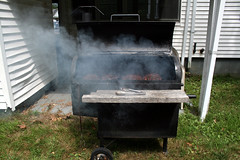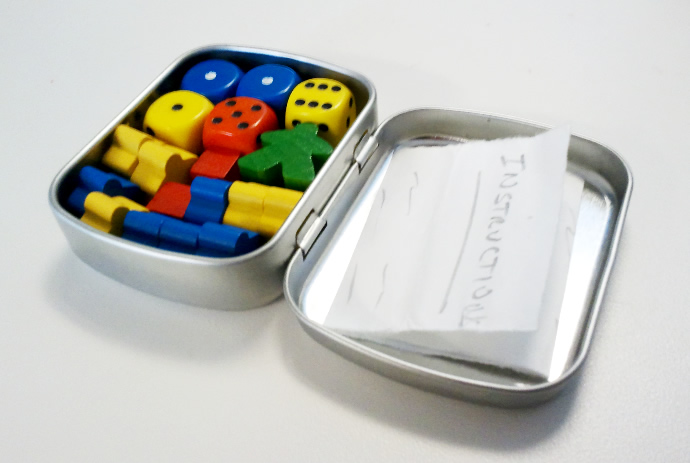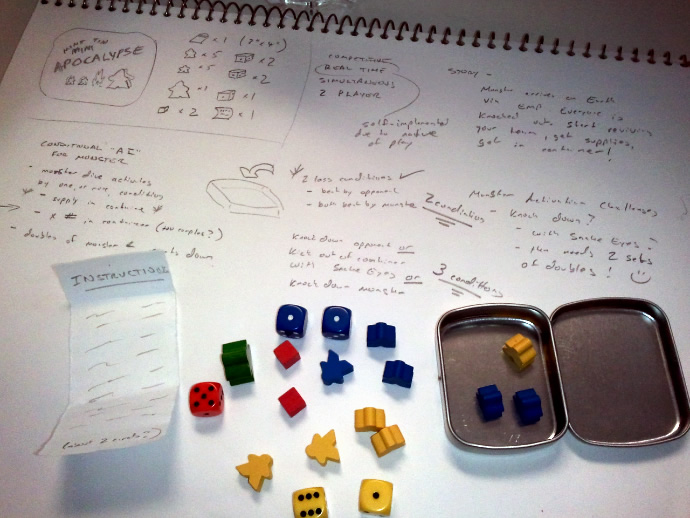Designing games is fun – after all, they’re games! =D
I carry little notebooks with me that I jot ideas into, do pricing calculations, draw out game titles, and doodle in.
BUT . . . as a game gets to a critical point, such as just before play testing with the game design meetup group and again before play testing with strangers, I like drawing it out in an 11″ by 14 ” spiral-bound sketch book.
 I figure if I can’t make it smoothly flow on paper, I won’t be able to make it flow for whatever it is – website, eLearning course, 450 pound smoker, book (overall arc), or game. *yes, I melted the vinyl siding in that pic!* =p
I figure if I can’t make it smoothly flow on paper, I won’t be able to make it flow for whatever it is – website, eLearning course, 450 pound smoker, book (overall arc), or game. *yes, I melted the vinyl siding in that pic!* =p
I also use pencils without erasers – that keeps me from getting caught up in how straight a line is and forces me to stay focused on the overall brainstorming. There’s time, later, to refine drawings. =)
With games, it’s tempting to just start pulling components together – especially if you happen to have a zillion meeples, cubes, and dice laying around. =D
I do enjoy the form factor aspect of a game, so that figures prominently in the design, but as a high level guide that can change if it needs to for the sake of the game. For example, Mint Tin Mini Apocalypse (MTMA) started as a challenge from Kate to make a game that fits in an Altoids Smalls tin – about a third of a normal mint tin (actually 29%, see the math in this older post). That’s what form factor means to me, the final product’s packaging and/or other constraints.
Sketching the flow of a game creates a different perspective and helps me view it both holistically and to isolate each part of the game play.
Here’s what sketching out MTMA today did:
- Confirmed that a second way to lose fits without adding much to tiny its instructions:
- As a 2 player, simultaneous play game a bit like the Escape series, but without the need for a timer (soundtrack), this competitive game can end when one player wins. *duh, novel eh?* =p
- The second way to lose is via the monster which has some “AI” built in. Artificial Intelligence sounds a bit haughty to me but that’s the term people use and I guess it’s an accurate way to think of it. If the monster wins, both players lose. o_O
- Created a 3 condition part of the game that, until it was drawn out, was only 2. Sketching it out made clear that a third condition could:
- easily be added,
- made sense in the game play,
- added the opportunity for player strategy, and
- didn’t add complexity to the instructions.
- Reduced another 2 condition part to 1 condition:
- More conditions often make for more fun in the way of painful decisions (strategy options). But this one added complexity to the instructions AND added too much thinking for the chaos this game should convey.
I may have never made these changes without sketching and, for me, this requires discipline because I just want to start tossing dice and moving meeples! =D
Sketching it out also helps see options that a player may see on their own.
In Mint Tin Pirates, it was important to be really fast, like the possibility of 5 minutes, and that meant balancing the game to play without having to reshuffle discarded cards for the majority of games.
If you want the game to last longer, and don’t mind doing a reshuffle, simply add injured pirates to the game play. No need for extra meeples, just have the first successful attack lay a meeple down on the boat. This means a meeple can be standing or injured, thereby doubling the effective meeple count. And count up and down once on the cannon damage track, if desired.
Game players are clever people and leaving games open a bit allows for all kinds of creative twists, such as the “injured pirate” variation and Nick Shaw’s awesome solo and combo variants to the first set of Mint Tin Games.
Happy gaming over the holidays! =)


